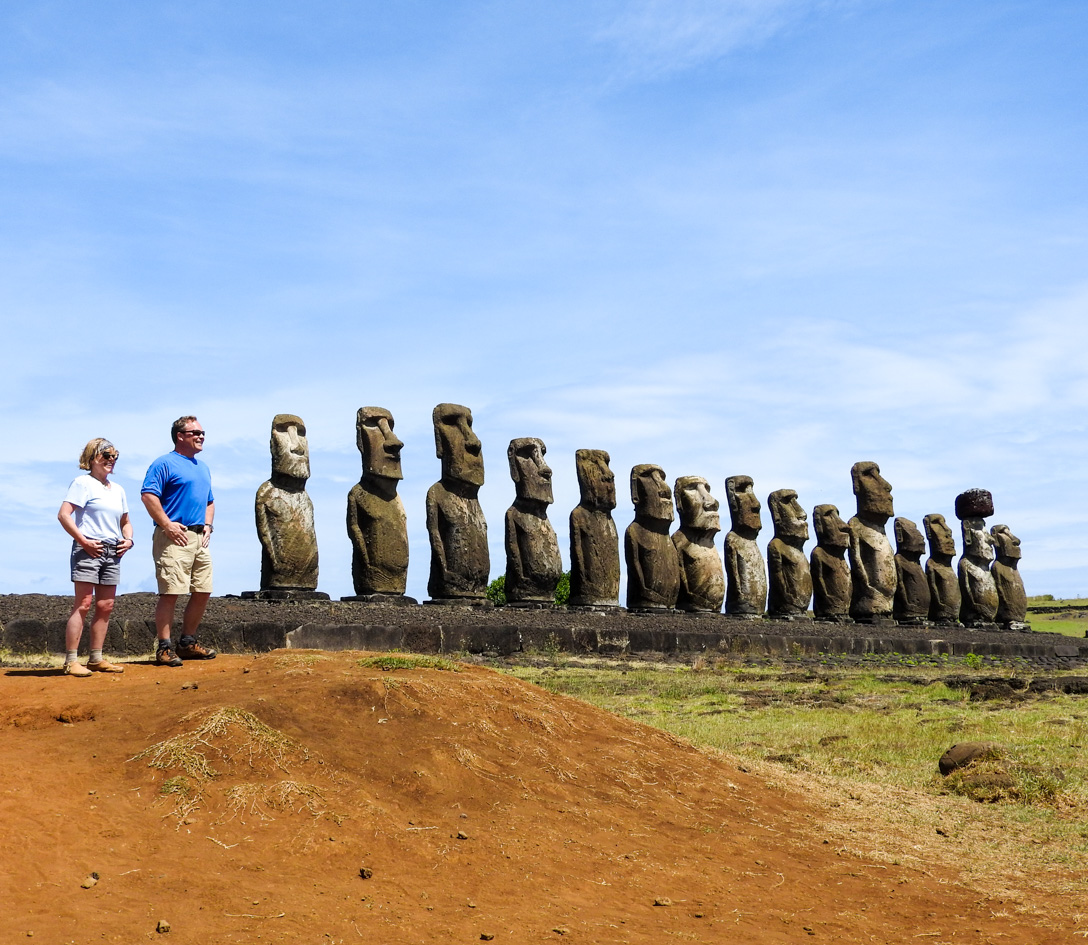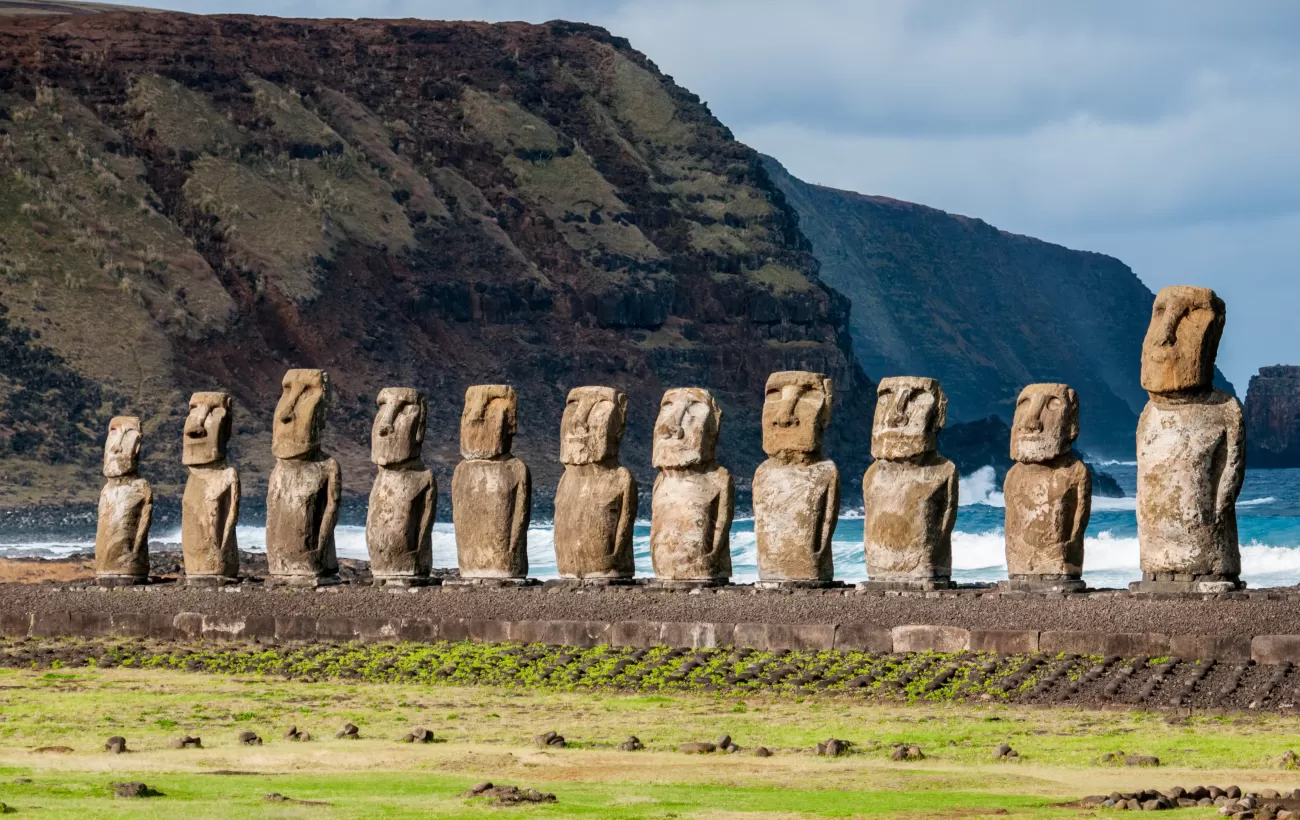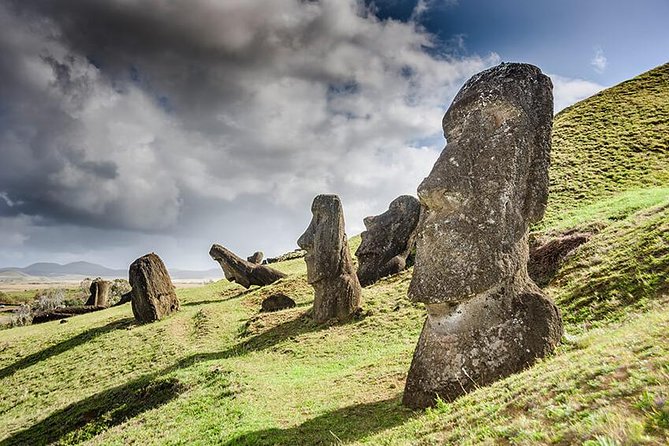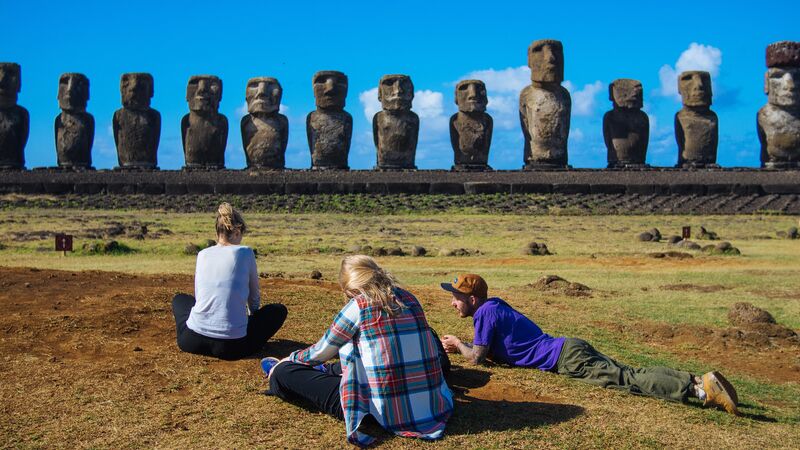An Easter Island trip refers to a journey to Rapa Nui, a remote island in the southeastern Pacific Ocean, which is a part of Chile.
Famous for its Moai statues, Easter Island is a top destination for travelers interested in history, archaeology, and natural beauty.
The island is known for its mysterious, giant stone figures that were created between the 13th and 16th centuries, representing deified ancestors of the island’s ancient Polynesian inhabitants.
Key highlights of an Easter Island trip include visiting the iconic Moai statues at Rano Raraku, the volcanic quarry where most of the statues were carved, and Ahu Tongariki, the largest ceremonial platform.
The island’s Ahu platforms, which served as ceremonial sites, offer a glimpse into the island’s ancient cultural practices.
Beyond its archaeological wonders, Easter Island also features stunning landscapes, including volcanic craters, pristine beaches like Anakena Beach, and dramatic cliffs.
Visitors can also explore Rapa Nui National Park, a UNESCO World Heritage site, which protects most of the island’s archaeological and natural attractions.
Why Visit Easter Island?
Easter Island, or Rapa Nui, is one of the most unique and remote destinations in the world, offering a combination of mystical history, stunning landscapes, and rich culture that make it an unforgettable travel experience.
Here are several reasons why you should consider visiting Easter Island:
The Mysterious Moai Statues
Easter Island is famous for its Moai statues, colossal stone figures that were carved between the 13th and 16th centuries.
These statues, some standing over 30 feet tall, were created by the island’s Polynesian ancestors and remain a wonder of engineering and artistry.
Visiting the Rano Raraku Quarry, where the Moai were carved, and Ahu Tongariki, the largest ceremonial platform, is a must-do for history and culture enthusiasts.
Rich Polynesian Culture
Easter Island has a deeply rooted Polynesian culture, and exploring its history is part of the allure. The island’s people, known as the Rapa Nui, have a fascinating heritage, with stories, traditions, and language that date back centuries.
Visiting the Rapa Nui National Park and engaging with the island’s local community offers insight into their ancient and vibrant culture.
Breathtaking Natural Beauty
Beyond the Moai statues, Easter Island boasts a stunning landscape of volcanic craters, dramatic cliffs, and beautiful beaches.
Anakena Beach, with its soft white sand and crystal-clear waters, is perfect for relaxing, while the Rano Kau Crater and its nearby cliffs provide incredible panoramic views of the island.
UNESCO World Heritage Site
Easter Island is a UNESCO World Heritage Site, thanks to its archaeological importance and preservation of both cultural and natural heritage.
This designation ensures that the island’s unique sites and ecosystems are protected, making it a place where visitors can experience history up close and contribute to preserving it for future generations.
Adventure and Solitude
Easter Island is one of the most isolated inhabited places on Earth, making it a perfect getaway for those seeking peace, solitude, and adventure.
With fewer crowds compared to more popular destinations, it offers a serene escape, perfect for exploration, hiking, and learning about the island’s ancient mysteries.
Unique Wildlife and Nature
The island’s wildlife, including sea birds and marine life, is another reason to visit. For nature lovers, the opportunity to hike through volcanic landscapes, discover hidden caves, and explore underwater ecosystems while snorkeling or diving adds another dimension to the Easter Island experience.
Best Time to Travel to Easter Island

Easter Island is a year-round destination, but the best time to visit depends on your preferences for weather, crowds, and activities.
Here’s a breakdown of what to expect throughout the year:
Peak Season (December to February)
The peak season on Easter Island coincides with the Southern Hemisphere’s summer months. This is the most popular time to visit due to the warm weather, with average temperatures ranging from 70°F to 80°F (21°C to 27°C).
The island is vibrant with tourists, which means more activities, guided tours, and festivals. However, since it’s high season, accommodations can be more expensive, and popular sites may be busier.
Shoulder Season (March to May)
Late March to May is an excellent time to visit Easter Island if you prefer a more calm experience. The weather is still warm, but the crowds thin out as the peak season ends.
Average temperatures remain pleasant, ranging from 68°F to 76°F (20°C to 24°C), and you can enjoy the island’s beauty without feeling overwhelmed by tourists. This is also a great time to take advantage of lower hotel rates and discounts on tours.
Off-Season (June to August)
The winter months (June to August) are the off-season in Easter Island. While it’s colder, with temperatures ranging from 62°F to 70°F (17°C to 21°C), it’s still mild compared to other destinations. There’s also a higher chance of rain during this period.
However, if you don’t mind the cooler weather and occasional showers, this is the time to find the best deals on flights and accommodation. The island is quieter, offering a more intimate experience for those looking to explore in solitude.
Spring and Fall (September to November)
September to November offers a great balance between pleasant weather, fewer tourists, and reasonable prices. The temperatures are still moderate, around 65°F to 75°F (18°C to 24°C), and rainfall is low.
These months are perfect for those who want to enjoy the island’s natural beauty and archaeological sites without the summer crowds. It’s an ideal time for hiking, exploring Moai sites, and engaging in outdoor activities.
Top Things to Do on Easter Island

Easter Island, or Rapa Nui, is a place steeped in mystery, history, and natural beauty. Whether you’re a history buff, nature enthusiast, or adventure seeker, the island offers plenty of unique experiences.
Here are the top things to do when visiting Easter Island:
Visit the Moai Statues
The most iconic activity on Easter Island is visiting the Moai statues, large stone figures that represent the island’s ancestral spirits. Rano Raraku Quarry is the best place to see these statues in their original location, where they were carved out of volcanic rock. Ahu Tongariki, with its 15 standing Moai, is another must-see site. These statues are an awe-inspiring glimpse into the island’s ancient culture.
Explore the Rapa Nui National Park
The Rapa Nui National Park, a UNESCO World Heritage Site, protects most of the island’s archaeological wonders. You can hike through volcanic craters, visit ceremonial platforms (Ahu), and explore caves and petroglyphs. The park is an excellent way to experience the island’s history and natural beauty.
Hike to the Top of Rano Kau
Rano Kau is one of the island’s three extinct volcanoes. A hike to the top offers incredible views of the island, including the Orongo village, which has petroglyphs and ceremonial sites. The crater itself is filled with water, creating a serene and beautiful landscape.
Relax at Anakena Beach
Anakena Beach is one of the most beautiful beaches on the island, with soft white sand and turquoise waters. It’s also home to several Moai statues, making it a picturesque spot to relax and swim. The beach is perfect for enjoying the sun, having a picnic, or just soaking in the peaceful atmosphere.
Explore the Orongo Village
Orongo, located on the edge of the Rano Kau crater, is a historic site where the island’s birdman cult once thrived. The village offers a fascinating look at the ancient customs and beliefs of the island’s people, with petroglyphs and stone houses still standing. It’s also an excellent spot for panoramic views of the island and the ocean.
Snorkel or Dive at the Underwater Moai
For those seeking underwater adventures, Easter Island offers snorkeling and diving opportunities around sites like Motu Tautara. Divers can explore the rich marine life and, in some areas, even see submerged Moai statues that have been washed away from the shore.
Visit the Rapa Nui Museum
To learn more about the history and culture of Easter Island, a trip to the Rapa Nui Museum is highly recommended. The museum houses artifacts, ancient tools, and exhibits on the Moai statues, Rapa Nui history, and the island’s geology.
Go Horseback Riding
Exploring Easter Island on horseback is a great way to see some of its most remote and scenic locations. You can ride along beaches, visit secluded caves, and enjoy panoramic views of the island’s stunning landscapes.
Attend the Tapati Festival (February)
If you visit in February, don’t miss the Tapati Festival, Easter Island’s most important cultural event. The festival features traditional Rapa Nui music, dance, art, and athletic competitions. It’s a vibrant celebration of the island’s heritage and a great opportunity to experience local customs.
Hike to the Top of Terevaka
Terevaka is the highest point on Easter Island, standing at 507 meters (1,664 feet). The hike to the top rewards you with breathtaking 360-degree views of the island. On a clear day, you can see the entire island, as well as the surrounding ocean.
Local Culture and Traditions
Easter Island, or Rapa Nui, has a rich cultural heritage that dates back to its Polynesian settlers over a thousand years ago. The island’s history, traditions, and customs are deeply intertwined with its spiritual beliefs, ancient rituals, and artistic practices.
Here’s a glimpse into the vibrant culture and traditions of this remote island:
The Moai Statues and Ancestor Worship
At the heart of Easter Island’s culture are the Moai statues, which represent the island’s ancestral spirits. The Moai were created between the 13th and 16th centuries by the Rapa Nui people as a way to honor their ancestors and ensure their protection.
These statues are deeply linked to the island’s spirituality and ancestor worship, as it was believed that the Moai held the power to influence prosperity, health, and good harvests for the island’s communities.
The Birdman Cult and Orongo Ceremonies
One of Easter Island’s most fascinating traditions was the Birdman Cult, which centered around the worship of a bird deity.
The cult was practiced from the 16th century until the 19th century. The Orongo village, perched on the edge of the Rano Kau Crater, was the ceremonial center of this cult.
The most important event of the year was the Tangata Manu (Birdman competition), where competitors would swim to a nearby islet to collect the first manutara (sooty tern) egg and return it to Orongo. The winner would be crowned the Birdman, and their tribe would hold power for the year.
Language: Rapa Nui
The native language of Easter Island is Rapa Nui, a Polynesian language that is still spoken by many islanders. While Spanish is the official language, Rapa Nui is an important part of the island’s identity.
Efforts are being made to preserve and revive the language through local schools and cultural programs. Visitors are often encouraged to learn a few basic phrases as a way to connect with the local community.
Tapati Festival
The Tapati Festival, held every February, is the most significant cultural celebration on Easter Island. This vibrant festival honors Rapa Nui traditions through a series of competitions, music, dance, and art.
The festival includes traditional events like the Koro-rapa (canoe race), Rapa Nui dance performances, and athletic contests such as stone carrying and spear throwing.
The highlight of the festival is the selection of the Tapati Queen, who is chosen based on her performance in cultural and athletic events. The festival is a true celebration of Rapa Nui identity and is an unforgettable experience for visitors.
Rapa Nui Music and Dance
Music and dance are key elements of Rapa Nui culture. Traditional Rapa Nui dances, accompanied by drumming and chanting, are performed during celebrations and festivals.
The Hoko dance, for example, is a ceremonial dance that mimics the movements of the Moai and represents the ancestors. Music is also central to the Tapati Festival, where groups perform traditional songs that tell stories of the island’s history, mythology, and daily life.
Arts and Crafts
Easter Island is home to a distinctive artistic tradition that reflects its Polynesian roots. The most famous form of local craftsmanship is wood carving, where artisans create beautiful figurines, masks, and intricate designs.
Tattooing also holds cultural significance, with traditional motifs that tell the stories of the island’s people and their ancestors. Visitors can find handmade crafts, jewelry, and textiles at local markets and shops, providing a way to take home a piece of the island’s culture.
Cuisine and Traditional Food
Traditional Rapa Nui cuisine is based on fresh, locally grown ingredients, as well as seafood. Fish, tuna, and lobster are staples, often served with tropical fruits like papaya, mango, and pineapple. Taro and sweet potatoes are important root vegetables.
A traditional dish that reflects the island’s Polynesian heritage is umù, which is food cooked in an underground oven. For special occasions, you might also find pipi (shellfish) or roasted meats.
Respect for Nature and the Environment
The Rapa Nui people have always had a deep connection to nature. The island’s landscape, which includes volcanic craters, beaches, and forests, is considered sacred.
This respect for nature is part of the cultural fabric, with traditional practices focused on sustainable living, fishing, and farming. Modern-day conservation efforts are ongoing to protect the island’s unique ecosystem and archaeological sites.
Sustainable Tourism on Easter Island

Easter Island, or Rapa Nui, is a unique destination known for its historical significance, stunning landscapes, and cultural heritage.
As tourism increases, there is a growing awareness of the need to protect the island’s fragile environment and preserve its cultural treasures for future generations.
Sustainable tourism on Easter Island is essential to ensuring that the island remains a vibrant and preserved destination while benefiting both the local community and the environment.
Conservation of Archaeological Sites
Easter Island’s Moai statues and other archaeological sites are among the most significant cultural landmarks in the world. Many of these sites are protected under UNESCO’s World Heritage status, and efforts are in place to preserve them.
Sustainable tourism practices involve limiting the number of visitors to sensitive sites, using eco-friendly materials for visitor facilities, and providing education on how to respect these ancient structures. For example, tourists are encouraged not to touch the statues or climb on them to avoid erosion and damage.
Supporting Local Communities
Sustainable tourism focuses on supporting the local economy and ensuring that the benefits of tourism are distributed fairly across the community.
Locally owned businesses, including hotels, restaurants, and shops, are encouraged to adopt sustainable practices, such as using local produce, offering eco-friendly accommodations, and employing local guides.
By supporting Rapa Nui’s residents, tourism becomes a key tool for economic empowerment and cultural preservation, allowing the islanders to maintain their traditional ways of life while engaging in the modern economy.
Responsible Wildlife and Environmental Protection
Easter Island is home to unique ecosystems, including marine life and endemic plant species that are vulnerable to overuse and exploitation. Sustainable tourism on the island encourages visitors to respect wildlife and marine conservation areas.
For example, tourists are urged not to disturb nesting sea birds, including the manutara (sooty tern), which has cultural significance related to the Birdman Cult. Diving and snorkeling tours are regulated to ensure they do not harm fragile coral reefs and marine ecosystems.
Waste Management and Recycling
Easter Island’s remote location and limited infrastructure make waste management a significant challenge. Sustainable tourism initiatives focus on reducing waste by promoting recycling and minimizing plastic use.
Many businesses on the island are adopting sustainable practices, such as using biodegradable products, offering reusable water bottles, and reducing packaging. Visitors are encouraged to follow the same practices by carrying out their trash and respecting local recycling efforts.
Conclusion
Easter Island offers a once-in-a-lifetime opportunity to explore a unique and culturally rich destination. As tourism continues to grow, the need for sustainable practices becomes more important than ever.
By embracing responsible travel, visitors can help protect the island’s ancient Moai statues, pristine landscapes, and vibrant culture while ensuring that the local community thrives.
Sustainable tourism not only preserves the environment and cultural heritage of Easter Island but also fosters a deeper connection between travelers and the local people.
Whether through supporting eco-friendly businesses, minimizing environmental impact, or learning about the island’s traditions, every visitor plays a crucial role in maintaining the delicate balance between tourism and conservation.
Ultimately, sustainable tourism on Easter Island ensures that this extraordinary destination can be enjoyed by future generations, just as it is today.

